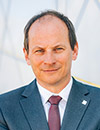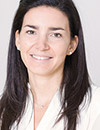Plenary Event
Tuesday Plenary Session
8 April 2025 • 09:00 - 10:40 CEST | Nadir
9:00 to 9:05
Welcome and Introduction
Pavel Bakule, ELI Beamlines (Czech Republic)
Saša Bajt, Deutsches Elektronen-Synchrotron (Germany)
Optics + Optoelectronics Symposium Chairs
9:05 to 9:50
Advancing fusion: tackling challenges in inertial fusion energy

Constantin Häfner
Fraunhofer-Institut für Lasertechnik ILT (Germany)
In 2022, laser-driven inertial confinement fusion (ICF) achieved a groundbreaking milestone by generating more energy than it consumed. This monumental feat was made possible by the world’s largest and most powerful laser, the National Ignition Facility in the United States, which propelled plasma confinement and ignition into the spotlight.
Prof. Dr. Constantin Häfner is the Senior Executive Vice President for Research and Transfer at Fraunhofer-Gesellschaft and a Full Professor at RWTH Aachen University. Until recently, he served as the Managing Director of the Fraunhofer Institute for Laser Technology ILT and chaired the BMBF Expert Commission on Inertial Fusion Energy for the German government. He previously held the position of Director of the Advanced Photon Technologies Program at Lawrence Livermore National Lab in the USA. As a distinguished expert in advanced high-energy laser science and technology, especially in the realm of Inertial Confinement Fusion applications, he has made significant and pioneering contributions to the field.
9:55 to 10:40
Advancements in attosecond technology and applications

Francesca Calegari
Deutsches Elektronen-Synchrotron DESY (Germany)
The Nobel Prize in Physics awarded in 2023 underscored the transformative potential of attosecond light sources, which now grant us unprecedented insights into the electron time scale within matter. This advancement has paved the way for the emergence of attochemistry1, a novel field aiming at manipulating chemical reactivity through the precise driving of electronic motion.
In this presentation, I will first give an overview of our latest developments towards compact fewfemtosecond ultraviolet sources and VUV/soft-x ray attosecond sources. Additionally, I will highlight a variety of applications ranging from nanoplasmonic field sampling to the real-time tracking of ultrafast charge migration in photoexcited molecules2 with significant steps toward achieving charge-directed reactivity3— the ultimate objective of attochemistry.
References
1. F. Calegari, F. Martin, Commun Chem 6, 184 (2023)
2. F. Calegari et al, Science 346, 336 (2014)
3. V. Wanie et int., and F. Calegari, Nature 630, 109–115 (2024)
Francesca Calegari leads the Attosecond Science division at the Center for Free-Electron Laser Science at DESY. She is also a full professor of physics at Universität Hamburg. Amongst other distinctions, she received the ICO prize and the Ernst Abbe medal from the International Commission of Optics and she is a Fellow of the Optical Society (Optica).
Welcome and Introduction
Pavel Bakule, ELI Beamlines (Czech Republic)
Saša Bajt, Deutsches Elektronen-Synchrotron (Germany)
Optics + Optoelectronics Symposium Chairs
9:05 to 9:50
Advancing fusion: tackling challenges in inertial fusion energy

Constantin Häfner
Fraunhofer-Institut für Lasertechnik ILT (Germany)
In 2022, laser-driven inertial confinement fusion (ICF) achieved a groundbreaking milestone by generating more energy than it consumed. This monumental feat was made possible by the world’s largest and most powerful laser, the National Ignition Facility in the United States, which propelled plasma confinement and ignition into the spotlight.
However, realizing practical energy production from ICF is not without its challenges. The future demands significant advancements across several fundamental technologies: improving the efficiency and precision of laser systems, developing robust final optics, enhancing the efficiency and output of diode bars, and refining target design for uniform compression are just a few of the hurdles we must overcome.
This is where the critical importance of photonics and fundamental research comes into play. Continued interdisciplinary collaboration is essential to tackle these challenges and unlock the vast potential of ICF as a sustainable and abundant energy source. These challenges are not merely technical; they represent a clarion call for innovation in a field that has the power to revolutionize our energy future.
Prof. Dr. Constantin Häfner is the Senior Executive Vice President for Research and Transfer at Fraunhofer-Gesellschaft and a Full Professor at RWTH Aachen University. Until recently, he served as the Managing Director of the Fraunhofer Institute for Laser Technology ILT and chaired the BMBF Expert Commission on Inertial Fusion Energy for the German government. He previously held the position of Director of the Advanced Photon Technologies Program at Lawrence Livermore National Lab in the USA. As a distinguished expert in advanced high-energy laser science and technology, especially in the realm of Inertial Confinement Fusion applications, he has made significant and pioneering contributions to the field.
9:55 to 10:40
Advancements in attosecond technology and applications

Francesca Calegari
Deutsches Elektronen-Synchrotron DESY (Germany)
The Nobel Prize in Physics awarded in 2023 underscored the transformative potential of attosecond light sources, which now grant us unprecedented insights into the electron time scale within matter. This advancement has paved the way for the emergence of attochemistry1, a novel field aiming at manipulating chemical reactivity through the precise driving of electronic motion.
In this presentation, I will first give an overview of our latest developments towards compact fewfemtosecond ultraviolet sources and VUV/soft-x ray attosecond sources. Additionally, I will highlight a variety of applications ranging from nanoplasmonic field sampling to the real-time tracking of ultrafast charge migration in photoexcited molecules2 with significant steps toward achieving charge-directed reactivity3— the ultimate objective of attochemistry.
References
1. F. Calegari, F. Martin, Commun Chem 6, 184 (2023)
2. F. Calegari et al, Science 346, 336 (2014)
3. V. Wanie et int., and F. Calegari, Nature 630, 109–115 (2024)
Francesca Calegari leads the Attosecond Science division at the Center for Free-Electron Laser Science at DESY. She is also a full professor of physics at Universität Hamburg. Amongst other distinctions, she received the ICO prize and the Ernst Abbe medal from the International Commission of Optics and she is a Fellow of the Optical Society (Optica).
The main focus of her research is to track and ideally control in real time the electron dynamics occurring in systems with increasing complexity from simple molecules to molecules of biological interest and nanostructured materials. To this purpose, her group develops state-of-the-art table-top light sources providing extreme time resolution and spanning from the infrared wavelengths to the soft-x ray spectral range. She exploits attosecond technology to understand the role of electron dynamics in the photochemistry of biochemically relevant molecules including chiral molecules. Her research aims at the optimization of those process for efficient artificial light harvesting.
